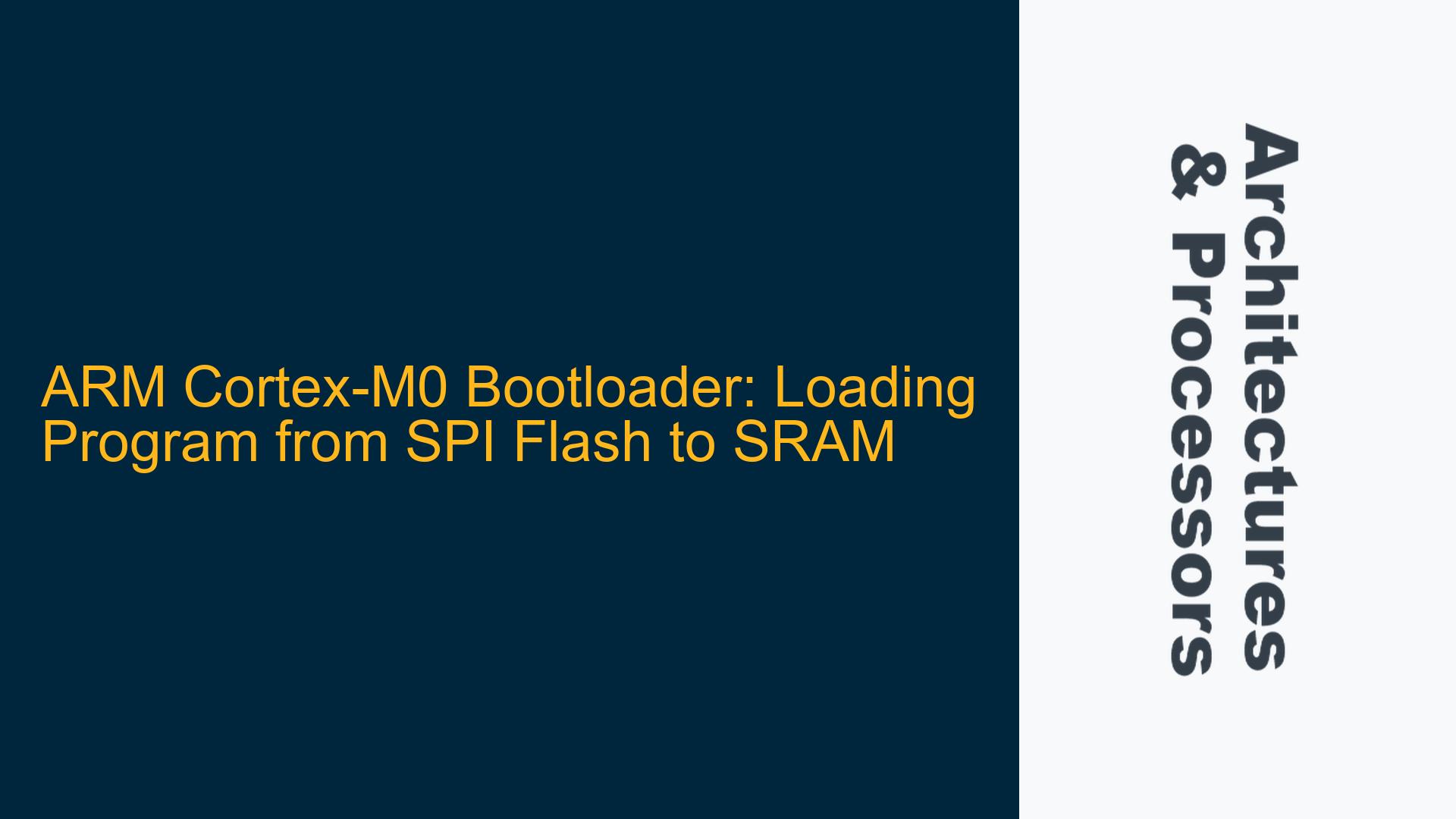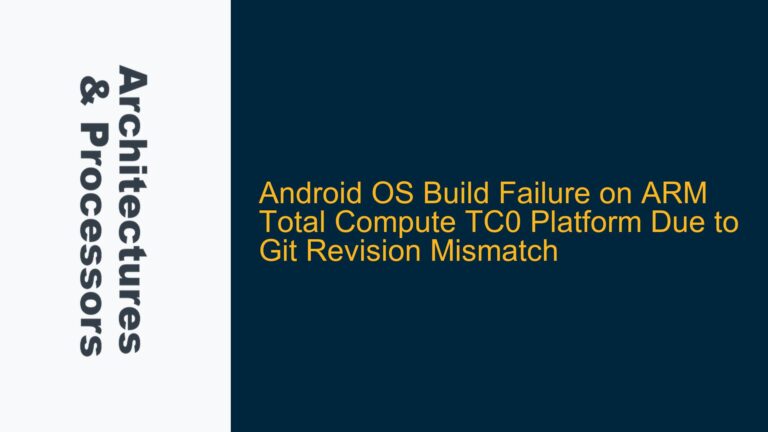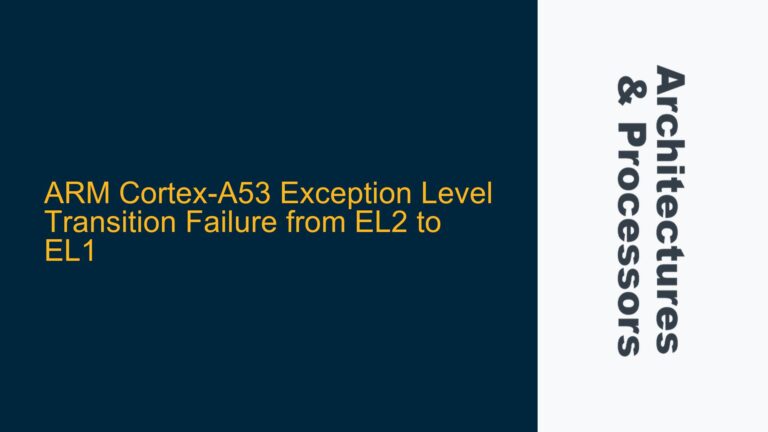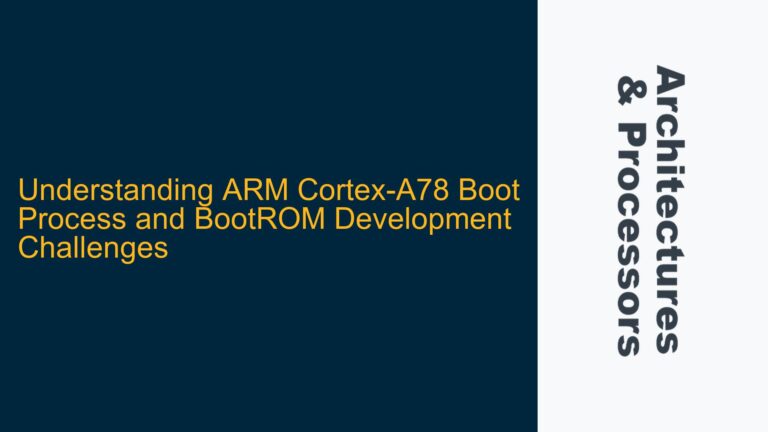ARM Cortex-M0 Bootloader Challenges with SPI Flash and SRAM Mapping
The ARM Cortex-M0 is a popular choice for low-power, cost-sensitive embedded systems due to its simplicity and efficiency. However, its minimalistic architecture can present challenges when implementing advanced features such as bootloading from external SPI Flash memory. One such challenge arises when attempting to load a program from SPI Flash into an external SRAM connected to the Program Memory space. The Cortex-M0 memory map and remapping capabilities complicate this process, especially when the system lacks internal Flash memory. This post delves into the core issues, explores possible causes, and provides detailed troubleshooting steps and solutions to address the problem.
Memory Remapping Constraints and Program Memory Access Limitations
The Cortex-M0 architecture provides a memory remapping feature that allows the bootloader to switch the memory map at runtime. When remap=1, the Program Memory space is typically mapped to internal Flash or SRAM. However, in systems without internal Flash, external memory such as SRAM must be used to store the program. The primary issue arises when attempting to write directly to the Program Memory space after remapping. The Cortex-M0 does not natively support direct writes to the Program Memory space when remap=1, as this space is intended for read-only access during normal operation.
The memory map of the Cortex-M0 is divided into several regions, including the Code region (0x00000000 to 0x1FFFFFFF), SRAM region (0x20000000 to 0x3FFFFFFF), and peripheral regions (0x40000000 and above). When remap=1, the Code region is typically mapped to internal Flash or a predefined memory block. However, if external SRAM is connected to this space, the Cortex-M0’s memory protection unit (MPU) and address decoding logic may prevent direct writes to this region. This limitation forces developers to use indirect methods, such as APB peripherals, to write to the SRAM.
The address decoding module plays a critical role in determining how memory accesses are routed. By default, the address decoder maps the Program Memory space to internal Flash or a predefined memory block. To enable direct writes to the SRAM connected to the Program Memory space, the address decoder must be modified to redirect transactions to the appropriate memory region. This requires a deep understanding of the memory map, address decoding logic, and the Cortex-M0’s remapping capabilities.
APB Peripheral Dependency and Address Decoder Configuration
The use of an APB peripheral to indirectly write to the SRAM highlights a workaround for the Cortex-M0’s memory access limitations. APB peripherals, such as GPIOs or custom-designed memory controllers, can be used to transfer data from the SPI Flash to the SRAM. However, this approach introduces additional complexity and potential performance bottlenecks. The APB bus operates at a lower frequency than the system bus, which can slow down data transfers. Additionally, the use of an APB peripheral requires additional firmware to manage the data transfer process, increasing the bootloader’s code size and execution time.
The address decoder configuration is another critical factor influencing the system’s behavior. The address decoder determines how memory accesses are routed to different memory regions and peripherals. By default, the address decoder maps the Program Memory space to internal Flash or a predefined memory block. To enable direct writes to the SRAM connected to the Program Memory space, the address decoder must be modified to redirect transactions to the appropriate memory region. This requires a deep understanding of the memory map, address decoding logic, and the Cortex-M0’s remapping capabilities.
The address decoder configuration can be modified in several ways. One approach is to update the address decode module to map a specific 64KB region to the SRAM when remap=1. This involves modifying the address decoder’s logic to recognize accesses to the Program Memory space and redirect them to the SRAM. Another approach is to use a memory controller peripheral to manage the memory mapping dynamically. This approach provides greater flexibility but requires additional hardware and firmware support.
Implementing Direct SRAM Access and Optimizing Bootloader Performance
To enable direct writes to the SRAM connected to the Program Memory space, the address decoder must be modified to redirect transactions to the appropriate memory region. This involves updating the address decode module to recognize accesses to the Program Memory space and map them to the SRAM. The following steps outline the process of implementing this solution:
-
Analyze the Memory Map and Address Decoder Configuration: Begin by reviewing the system’s memory map and address decoder configuration. Identify the memory regions and peripherals that are currently mapped to the Program Memory space. Determine how the address decoder routes accesses to these regions and identify any constraints or limitations.
-
Modify the Address Decoder Logic: Update the address decode module to recognize accesses to the Program Memory space and redirect them to the SRAM. This may involve adding new logic to the address decoder or modifying existing logic to support the new memory mapping. Ensure that the modified address decoder logic is compatible with the Cortex-M0’s remapping capabilities and does not introduce any conflicts or errors.
-
Verify the Memory Mapping: After modifying the address decoder, verify that the memory mapping is correct. Use a debugger or memory inspection tool to confirm that accesses to the Program Memory space are correctly routed to the SRAM. Test the system with different memory access patterns to ensure that the memory mapping is consistent and reliable.
-
Optimize the Bootloader Performance: Once the memory mapping is verified, optimize the bootloader’s performance to minimize the time required to load the program from the SPI Flash to the SRAM. This may involve optimizing the data transfer process, reducing the bootloader’s code size, or improving the system’s clock configuration. Use profiling tools to identify performance bottlenecks and implement optimizations to address them.
-
Test the System Under Different Conditions: Finally, test the system under different conditions to ensure that it operates reliably. Verify that the bootloader can successfully load the program from the SPI Flash to the SRAM and that the system can execute the program correctly. Test the system with different program sizes, memory configurations, and operating conditions to ensure that it is robust and reliable.
By following these steps, developers can implement a solution that enables direct writes to the SRAM connected to the Program Memory space and optimizes the bootloader’s performance. This approach provides a robust and reliable solution for loading programs from SPI Flash to SRAM on the Cortex-M0, enabling developers to leverage the full potential of this versatile microcontroller.
In conclusion, the challenges of loading a program from SPI Flash to SRAM on the ARM Cortex-M0 stem from the architecture’s memory remapping constraints and address decoding limitations. By understanding the memory map, modifying the address decoder, and optimizing the bootloader’s performance, developers can overcome these challenges and implement a robust solution. This approach not only addresses the immediate issue but also provides a foundation for future enhancements and optimizations, ensuring that the system remains flexible and scalable.






